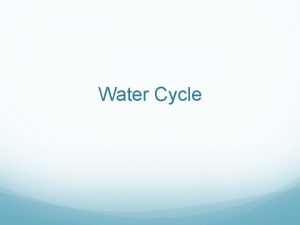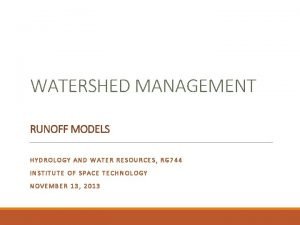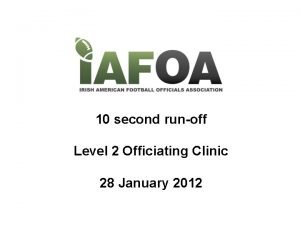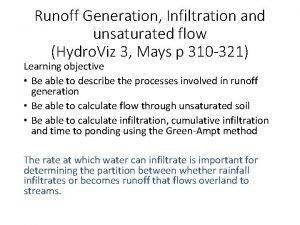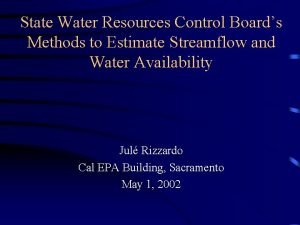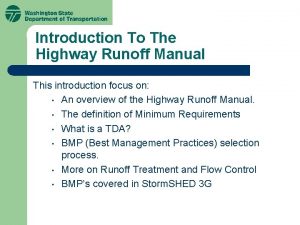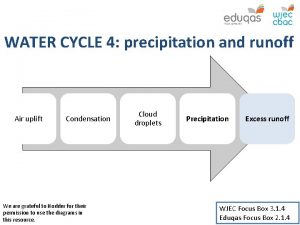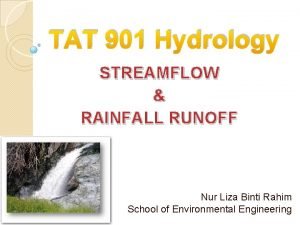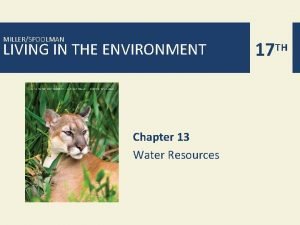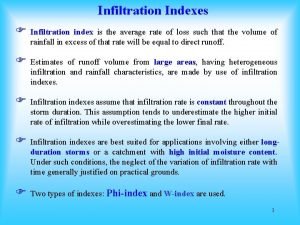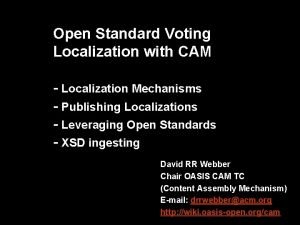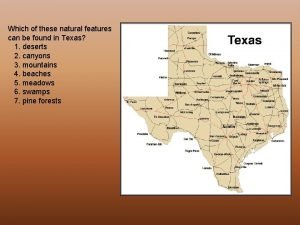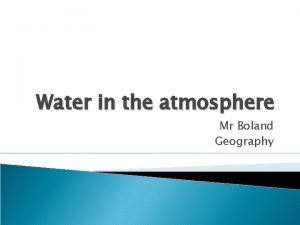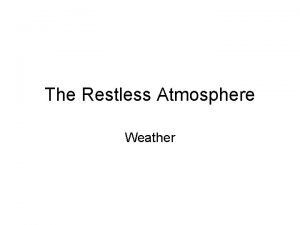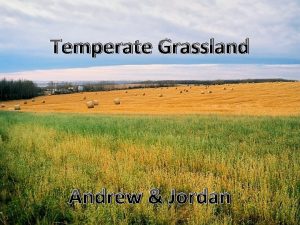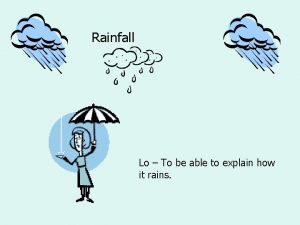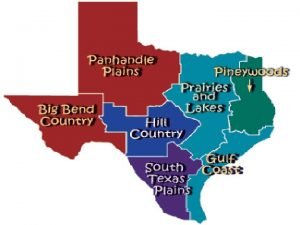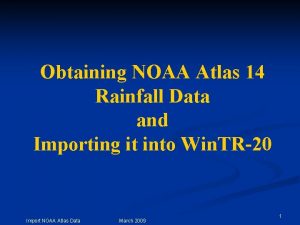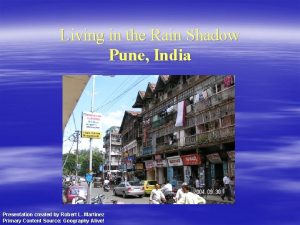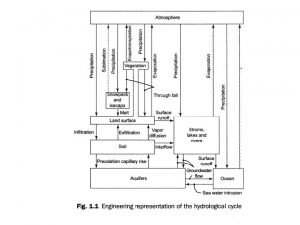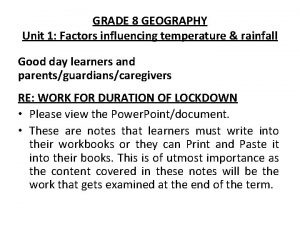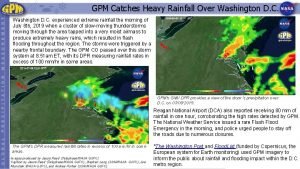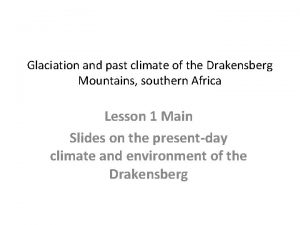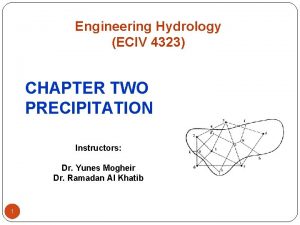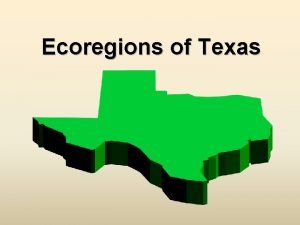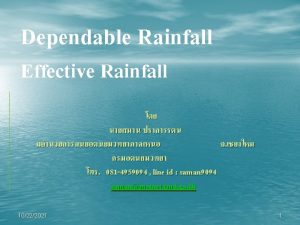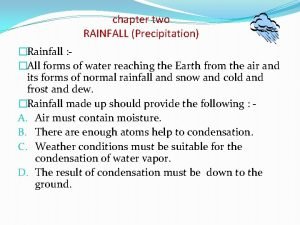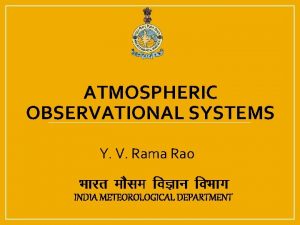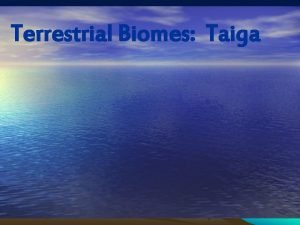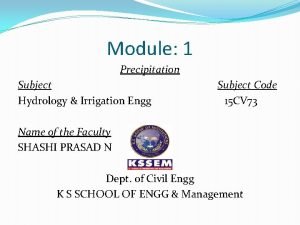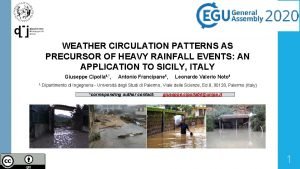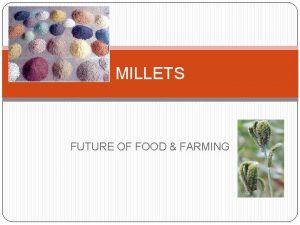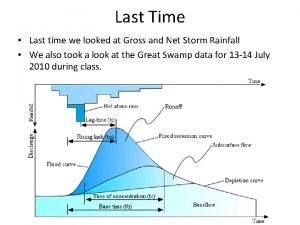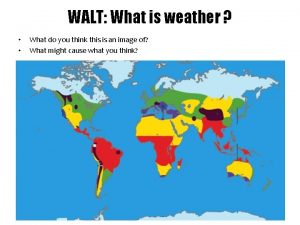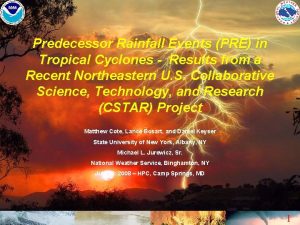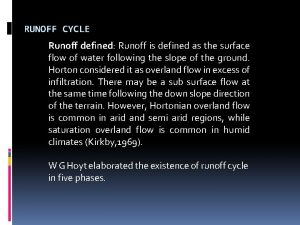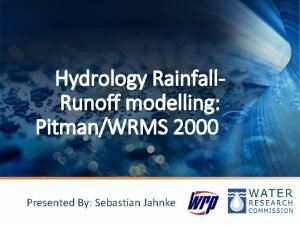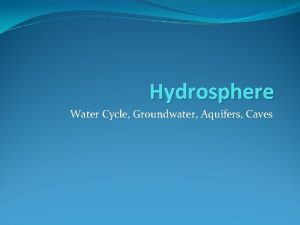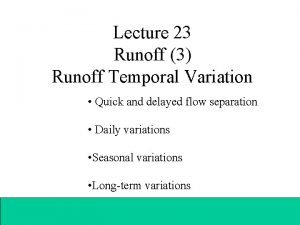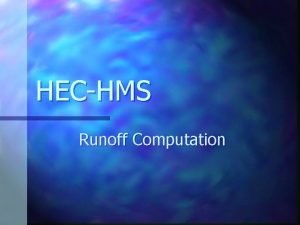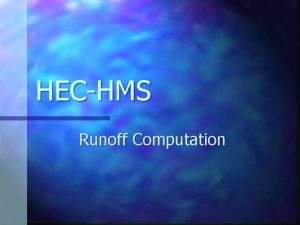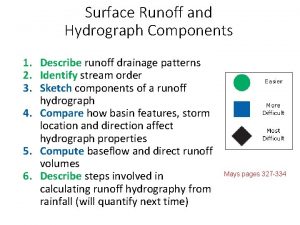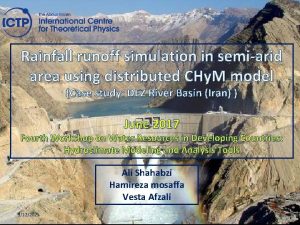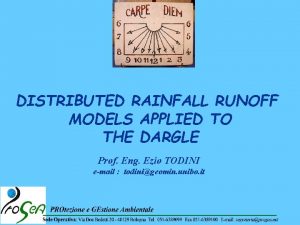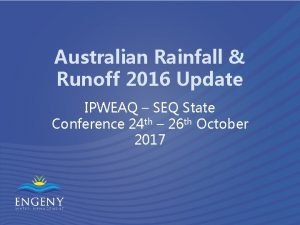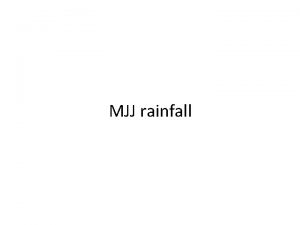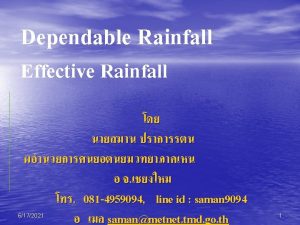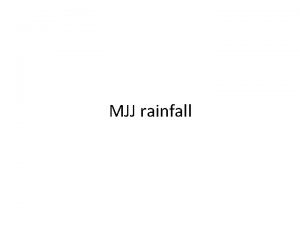Rainfall Runoff Modelling N V Umamahesh Water Environment












































- Slides: 44

Rainfall – Runoff Modelling N V Umamahesh Water & Environment Division Department of Civil Engineering National Institute of Technology, Warangal

Overview • • • Introduction – Hydrology and its applications Brief overview of Hydrologic Models Estimation of Flood Peak Discharge Hydrograph Analysis Flood Routing Models Case Studies of Urban Catchments – Amanisha Nallah in Jaipur – Flood Inundation Maps for Hyderabad

What is Hydrology? • • Study of water in the natural environment Its occurrence, circulation and distribution, its chemical and physical properties and its relation to living things A multidisciplinary field Engineering Hydrology / Applied Hydrology – Apply hydrologic knowledge for planning, design and operation of water resources systems

Engineering Hydrology – Typical Questions Answered • • What is the maximum probable flood at a given site? How does the yield from a catchment/ watershed vary from season to season and from year to year? What is the relationship between catchment’s surface and groundwater resources? When evaluating low flow characteristics, what flow can be expected to be exceeded 90 % of the time? Given the natural variability of streamflows, what is the appropriate size of a storage reservoir? What is the design discharge of a hydraulic structure? What is the risk of flooding at a given location/ site? What hydrologic hardware and software needed for real time flood forecasting?

Hydrologic Processes • • Precipitation Surface Water available for runoff Infiltration Percolation Evaporation and transpiration Concentration of chemical constituents Groundwater contribution to surface water bodies

Water Resources Systems • Water at: – Wrong place, wrong quantity, wrong time • • What to do? Manipulate the hydrologic cycle – Build facilities? • • Reservoirs Canals Flood Control Systems Other infrastructure

Hydrologic Modelling for Floods Mujumdar, P P, D Nagesh Kumar, Floods in a Changing Climate – Hydrologic Modeling, Cambridge University Press, 2012

Hydrologic Design • • Process of assessing the impact of hydrologic event on water resources systems and choosing the values for key variables of the system Used for – Develop plans for a new system • Design of urban stormwater drainage system • Design of flood control structures – Develop management plans for better control • Operation of urban drainage systems for flood control • Mapping flood prone areas

Systems Approach in Hydrologic Modelling • Physical Approach – Fundamental laws of physics are applied to study the movement of water on land – Difficult due to complex nature of hydrologic processes • Systems Approach – Physical processes and their interactions at different geometrical scales are not considered directly

Types of Hydrologic Models • Lumped Models: – Spatial parameters represented by spatially averaged parameters • • Semi-distributed Models Distributed Models: – Spatial variability of all the parameters is considered

Hydrologic Modeling Approaches Lumped Distributed 1. Rainfall, properties averaged over basin 1. Rainfall, properties in each grid 2. One rainfall/runoff model 2. Rainfall/runoff model in each grid 3. Prediction at only one point 3. Prediction at many points

Mass Balance Assuming constant density: • Forms the basis to most hydrological models For a typical watershed:

Rational Method • • Qp = CIA Intensity of rainfall – IDF relationship – Time of concentration – Return period/ Average recurrence interval • Runoff Coefficient – – • % of imperviousness Slope Land use Ponding characterisitics Deterministic and Probabilistic interpretation

Rational Method • Limitations – Too simple – Subjective – Gives only peak discharge • • Used widely for design of stormwater drainage systems Preliminary design – Adequacy needs to be tested using flow routing models

Limitations of Rational Method The formula is illogical because it assumes uniform rainfall which rarely occurs. Ø The formula incorrectly assumes that runoff is a fraction of the rainfall rather than a residual after abstractions. Ø The formula does not account for storage effects. Ø The determination of C is too difficult and too subjective. Ø

Infiltration Models • Horton’s model – Popularly used model due to its simplicity • Green-Ampt model – Most physically based model • SCS Model – Proposed for rural catchments, but also used for urban catchments – Extended to estimate the complete hydrograph

Unit Hydrograph • • • Unit hydrograph is the unit pulse response function of a linear hydrologic system The unit hydrograph of a catchment can be defined as the hydrograph of direct runoff resulting from one unit (1 cm) of effective rainfall occurring uniformly over the catchment at a uniform rate during a specified period of time. Assumptions involved – The effective rainfall has a constant intensity within the specified duration. – The effective rainfall is uniformly distributed throughout the whole drainage area. – The base time of the direct runoff hydrograph (DRH) resulting from an effective rainfall of given duration is constant. – The ordinates of all DRH’s of a common base time are directly proportional to the total amount of direct runoff represented by each hydrograph. – For a given catchment, the hydrograph resulting from a given excess rainfall reflects the unchanging characteristics of the watershed.

Properties of a Linear System • Come from theory on homogeneous linear differential equations – Proportionality - if the function f is a solution then cf is a solution where c is a constant. – Superposition - if f 1 and f 2 are solutions then f 1+f 2 is also a solution

Impulse Response Function O, I Unit Impulse Response Function u(t-t) t Time (t) The impulse response function is the characteristic function of a linear system

Convolution Integral O, I c 1 u(t-t 1) + c 2 u(t-t 2) c 2 t 1 t 2 Time (t) • A continuous input, I(t), can be regarded as a sequence of instantaneous inputs and hence the output is given by, Convolution Integral

Response Functions of Linear Systems • • Impulse Response Function Step Response Function Pulse Response Function Discrete Pulse Response Discrete form of convolution integral Source: V T Chow, D R Maidment, L W Mays, Applied Hydrology, Mc. Graw Hill International Edition, 1988

Unit Hydrograph • Derivation of DRH from ERH – discrete convolution equation • Derivation of unit hydrograph – Deconvolution using past data – Synthetic methods • Matrix method of deconvolution (Least square method) – PU = Q – U = (PTP)-1 PTQ

p 2 p 1 p 3 P 4=0 P 5=0 h 2 p 2 h 2 p 1 h 1 p 2 h 3 p 1 h 1 p 3 h 2 p 3 h 3 p 2 h 4 p 1 h 3 p 3 h 4 p 2 h 3 p 1+ h 2 p 2 + h 1 p 3 h 4 p 1+ h 3 p 2 + h 2 p 3+ h 1 p 4 h 2 p 1+ h 1 p 2 h 1 p 1 h 4 p 2 + h 3 p 3+ h 2 p 4 + h 1 p 5 P 1 no influence h 4 p 3 + h 3 p 4+ h 2 p 5 + h 1 p 6

Synthetic Unit Hydrograph • • The parameters of the UH are related to the catchment characteristics UH parameters – Time to peak – Peak discharge – Base time • Catchment characteristics – Length of the catchment – Shape of the catchment – Slope • Methods – Snyder’s method, CWC method, SCS Method

Flood Routing Models • • Hydrologic Models compute the flood hydrograph at the outlet of the sub-basin Hydrologic models do not consider the hydrodynamic characteristics of the propagation of the flood through the river channel Flood routing models route the flood through the river/ drainage network taking inputs from hydrologic models Classification: – One dimensional models – Two dimensional models – 1 D-2 D coupled models

One Dimensional Flow Routing Model • • Saint Vanant equations - One dimensional distributed flow routing model to route runoff through drainage channels Conservative Form: • Nonconservative Form:

Simplifications •

Kinematic Wave Model •

Hydrologic Flood Routing • •

Limitations of 1 -D models • • Cannot model network overflow phenomenon Not suitable to model flooding in urban areas Can efficiently predict the water levels in drains, but cannot predict the water levels in the flood plain Widely used for design of storm drainage networks

1 D-2 D Coupled Model • • Surface flow modeled by 2 D Saint-Venant equations Flow in drainage systems modeled as 1 D flow Coupling between the two models takes place at manholes Needs more computation time

Case Study – Urban Catchment Hydrological Modeling of Amanishah Nallah in Jaipur, Rajasthan

Rejuvenation of Amanishah Nallah (Dravyavathi River)

Catchment Map

Details of Catchment • • • Length – 47. 5 km Area – 241. 83 km 2 Divided into 23 sub-catchments Rainfall data – daily rainfall from 1976 -2015 100 years return period 24 h maximum rainfall = 311. 69 mm

Construction of Synthetic Unit Hydrograph • • • Total area is divided into 23 sub-catchments. Area, highest elevation, lowest elevation, slope, longest drainage length etc. Are calculated for each sub-catchment. Time of concentration for each sub-catchment is calculated using Kirpich formula • The basin lag (tp) is assumed as equal to 0. 6 Tc.

Construction of Effective Rainfall Hyetograph • • Daily rainfall broken into hourly rainfall using CWC procedure Effective rainfall estimated using SCS method • Weighted CN computed based on land use and soil type

Design Flow Hydrograph • • • Design hydrograph for each sub-catchment computed by convoluting effective rainfall hyetograph with 1 -h synthetic unit hydrograph Design hydrographs from each sub-catchment is routed through Amanishah Nallah using HEC-RAS software 1 -D unsteady flow module of HEC-RAS – uses implicit finite difference method

Design Hydrographs

Case Study Flood Inundation Maps for Hyderabad City

Drainage Map - Hyderabad Pilot Area: Hyderabad (650 Sq. Km) Geographical Location: 17. 3700° N, 78. 4800°E. Subcatchments: 16 Priority Preference zones: 1. Zone XII 2. Zone XIII and 3. Zone V Priorit y Zone 1 XII 2 XIII 3 V Area (Sq. Km) Outlet 143. 71 Hussain Sagar Lake 75. 29 21. 92 Musi Source: Greater Hyderabad Municipal Corporation

Simulation using HEC-RAS Spatial Data Storage and Processing in Arc-GIS 10. 1 Measured Data • Simulated the drainage system – 3 rainfall events – August 2000 – 312. 1 mm in 31 hours – August 2008 – 220. 7 mm in 36 hours – July 1989 – 199. 3 mm in 33 hours Interface to HEC Geo. HMS Model Output Stream Network, Subcatchments, Flow Lengths, Slopes Derivation of Basin Parameters HEC-HMS Rainfall Runoff Model Precipitation Data Output Stream Hydrographs at Basin Outlet HEC-RAS 1 D-2 D Hydraulic Model Digital Terrain Model Channel Geometry HEC-RAS 1 D HEC-RAS 2 D 2 D Mesh Generation Other Flow Parameters RAS Mapper Output Flood Plain Maps Boundary Conditions

Flood Inundation Map Rainfall (mm) 35 30 25 20 15 10 5 0 14. 00 15. 00 16. 00 17. 00 18. 00 19. 00 20. 00 21. 00 22. 00 23. 00 24. 00 1. 00 2. 00 3. 00 4. 00 5. 00 6. 00 7. 00 8. 00 9. 00 10. 00 11. 00 12. 00 13. 00 14. 00 15. 00 16. 00 17. 00 18. 00 19. 00 20. 00 21. 00 22. 00 23. 00 24. 00 1. 00 2. 00 3. 00 RAINFALL DATA (AUG 2000) Time (hh: mm)

Thank You
 Condensation in the water cycle
Condensation in the water cycle Water and water and water water
Water and water and water water Direct runoff hydrograph formula
Direct runoff hydrograph formula 10 second runoff nfl
10 second runoff nfl Runoff generation
Runoff generation Runoff coefficient
Runoff coefficient Highway runoff manual
Highway runoff manual In khosla's formula monthly losses is calculated as
In khosla's formula monthly losses is calculated as Air uplift
Air uplift What is a runoff sentence
What is a runoff sentence Factors affecting runoff
Factors affecting runoff How to prevent soil runoff on a slope
How to prevent soil runoff on a slope Scs method
Scs method Sequential runoff example
Sequential runoff example Instant runoff voting excel template
Instant runoff voting excel template Financial environment in business environment
Financial environment in business environment Llano uplift plants
Llano uplift plants Convectional rain
Convectional rain Convectional rainfall
Convectional rainfall Temperate grassland climate
Temperate grassland climate Where are temperate deciduous forest located
Where are temperate deciduous forest located What is relief rainfall
What is relief rainfall Llano uplift rainfall
Llano uplift rainfall Noaa atlas rainfall data
Noaa atlas rainfall data Pune, india, has tried to increase its rainfall by
Pune, india, has tried to increase its rainfall by Isohyetal method example problems
Isohyetal method example problems 5 factors that influence temperature and rainfall grade 8
5 factors that influence temperature and rainfall grade 8 Dc rainfall
Dc rainfall Drakensberg rainfall
Drakensberg rainfall Mass curve of rainfall
Mass curve of rainfall Texas ecoregion
Texas ecoregion What is dependable rainfall
What is dependable rainfall Rainfall
Rainfall Customised rainfall information system
Customised rainfall information system Temperate deciduous forest weather
Temperate deciduous forest weather Taiga location
Taiga location Cyclonic rainfall
Cyclonic rainfall Rainfall chapter 2
Rainfall chapter 2 Tsdps rainfall integration
Tsdps rainfall integration Rainfall for millets
Rainfall for millets Gross rainfall hyetograph
Gross rainfall hyetograph Grassy plain with irregular patterns of rainfall
Grassy plain with irregular patterns of rainfall What is weather
What is weather Predecessor rainfall event
Predecessor rainfall event Orographic rainfall
Orographic rainfall
